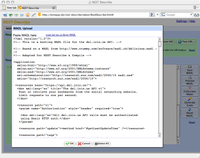Generate Code from your WADL REST API Descriptions with REST Describe & Compile


With today's v0.2 release of REST Describe & Compile I hope that some more people will respond to this comment with yes, it is. The new version allows for
- WADL creation based on sample request(s)
- WADL editing using an advanced interactive editor
- Code generation based on a WADL file which may be
- either created by REST Describe based on sample request(s),
- or uploaded from an external source into REST Describe
Recommended reading before getting started: WADL spec, REST Describe v0.1 release note, introduction to REST Compile by ProgrammableWeb.com
WADL feature support almost complete

WADL Parser allows for editing of existing descriptions

More RESTful behavior

Code Generation, or what I call REST Compile

You start with a template in each language:
runningOutOfDiskSpace = Caution, you only have {0} left.
runningOutOfDiskSpace = Achtung, Sie haben nur noch {0} übrig.
At runtime the program inserts the actual amount of available disk space, and only the strings that need to be localized are kept in the property file. Now back to the code generation idea. For instance functions or methods or whatever you want to call them exist in almost every programming language. There are slight differences, however, the main idea is the same. Have a look at two equivalent functions, the first in Ruby and the second in PHP:
|
|
Getting started
The source code is available under a BSD license. You can also check out the application directly in your browser. Therefore you might want to bookmark a link to the latest version of REST Describe & Compile. It is also available in German. Looking forward to hearing back from you. If you happen to be around Barcelona, Spain on June 27th - 29th, Patrick Chanezon and me will be co-presenting on TheServerSide.com Java Symposium. REST Describe & Compile will cover the second part of the presentation.
WADL is a great REST description language. You have done an awesome job, Marc! Hopefully other developers will pick up on this release, and make WADL the REST description language. Even if I would have named it differently, though ;-)
Yes, I do work for and get paid by Google for working on this project, but no, the project is not an official Google product. Period.
